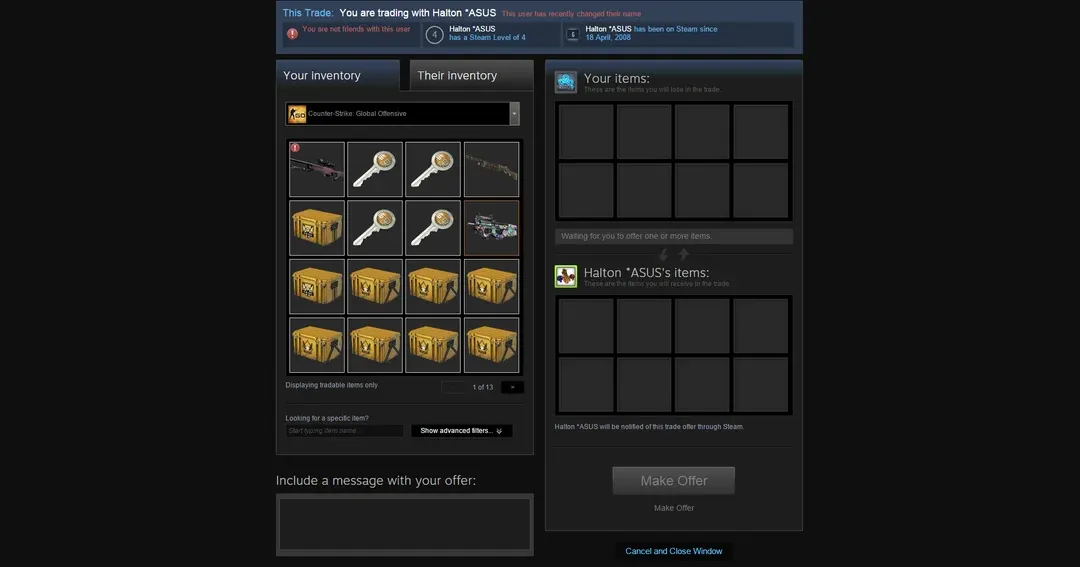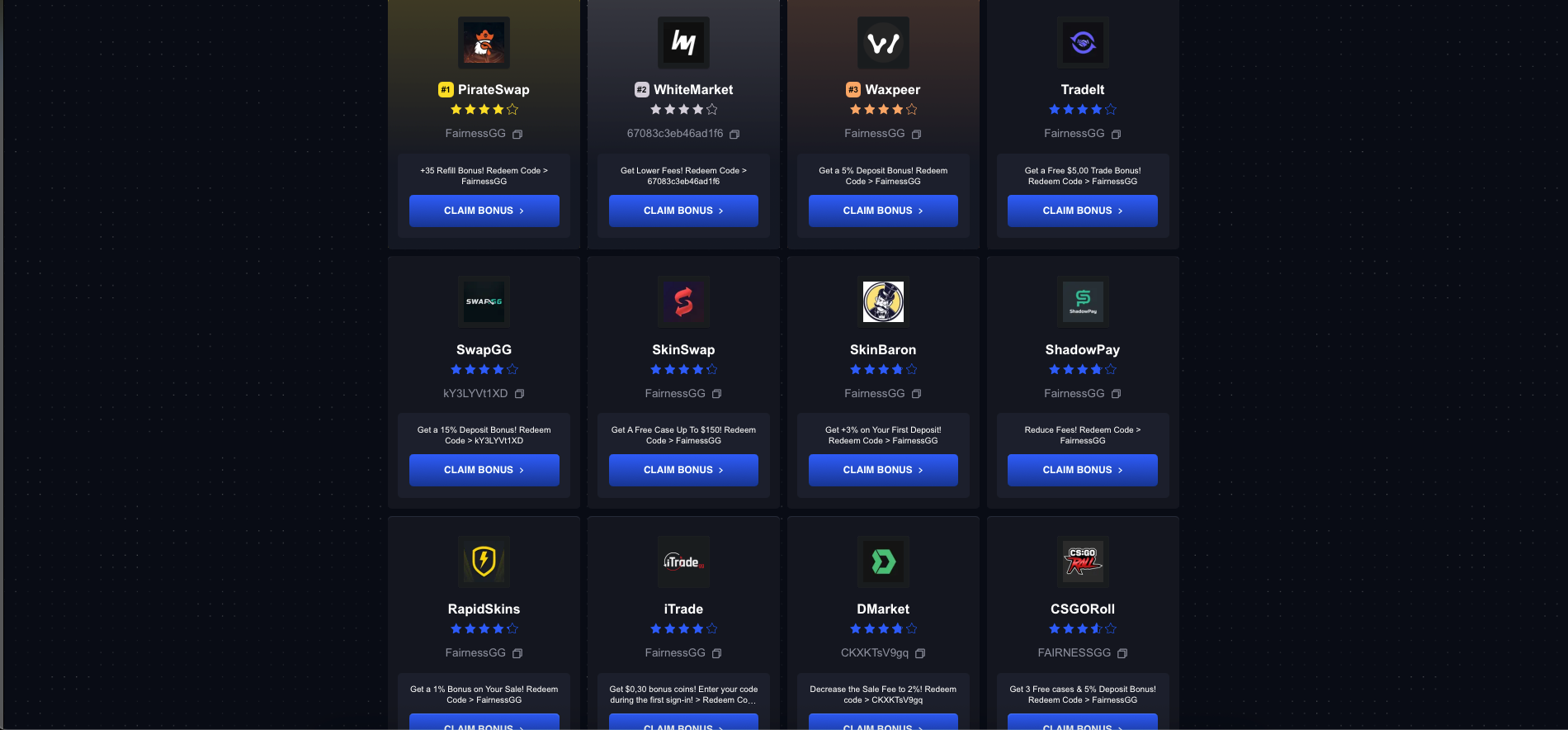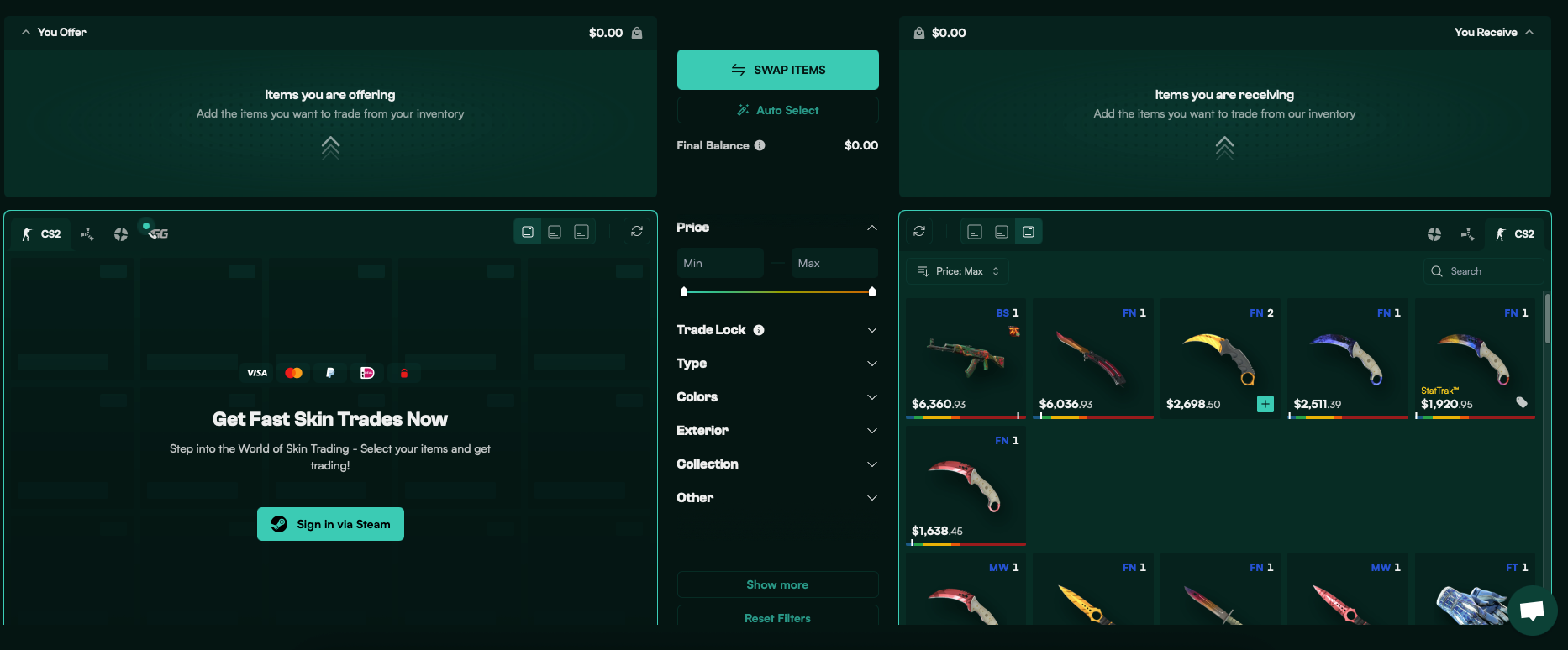Discover our blogs
get the latest updates, tips, and news from the world of skins, gaming, and fair trading.
get the latest updates, tips, and news from the world of skins, gaming, and fair trading.

CS2, Dota 2, and Rust skins serve as badges of achievement, potential investment, and even ways to earn lots of money. If you’re wondering how skin trading works for these games, you have landed at the right article. In this guide, we’ll walk you through the ins and outs of skin trading, covering the core mechanics, factors that influence skin prices, and much more. In addition, you’ll also find practical tips and the best skin trading platforms reviewed on our site to help you make the right choice.
In its purest form, skin trading is swapping or selling cosmetic items across a vast array of online sources, and in the case of games such as Dota 2, CS2, and Rust, this can start on the Steam Community Market, which is the official location in the eyes of Valve. There, you can list a skin in your possession, settle on a price and let people find out about it but remember that marketplaces cut down a substantial part of your earnings, averaging around 15 percent between Steam and the game publisher, and the remaining funds are bound to your Steam wallet, which can be used in the environment alone.

To be more flexible, particularly when you do wish to convert into real money, a third-party site, such as DMarket or TradeIt, intervenes and closes the gap. It is rather easy to set up: your Steam account should be connected, then a trade URL is created in the privacy settings, and that is all. These exchanges are mediated by automated bots that enable you to browse your existing collection, select what you are willing to accept in exchange, and seal the arrangement within seconds, albeit new acquisitions may be placed under a seven-day hold before they can be sold onward again.
The rates within this market are subject to change under the influence of various factors, including new cases of CS2 entering the population and depreciating values or new items in the Dota 2 Battle Pass that create so-called hype. The game updates also contribute, and a Rust patch adding a new utility to a tool might increase the popularity of this skin. Nevertheless, threats such as fraud-based websites, which can be used to copy the ones run by trustworthy businesses or phishing scams where scammers attempt to take over login credentials, are constantly prevalent, so it becomes a job criteria to turn on two-factor authentication and to check the URLs.

Using skin trading platforms that have been verified using fairness.gg, you reduce these risks and instead concentrate on the actual trading. As much as the Steam Market provides these safeguards, they are limited elsewhere to use third parties to transfer their money and exchange companies, where the fee can be as low as 5-8 percent and sometimes as high as 10 percent or more, depending on the site. The liquidity also fluctuates, and popular sites can execute the sale faster since more people visit. When you have decided to make money by flipping skins, it is worth keeping an eye on the daily tendencies, whether in built-in charts or external sources, and by doing that, trading becomes an art of preparation rather than good fortune.
In Dota 2, CS2, and Rust, skin prices are not fixed. They change due to a combination of factors, which every gamer ought to be knowledgeable of to be able to trade wisely. We list below the major factors that make a skin be worth what it is, with details per game to make it actionable and specific. Pay attention to these dynamics by checking platforms reviewed at fairness.gg.

Skins are sold by both gamer and non-gamer communities, with their reasons being akin to a combination of profit-making, aesthetic expression, and social status. The goal of many is to make money by flipping, buying low in the market at a time when there is a lull, and selling it when the hype has reached its height, with results capable of payoffs such as 20 percent on a correctly timed deal of a CS2 skin. Others focus on aesthetics and compile collections of bright neon weapons in CS2 or the attire of mythological heroes in Dota 2 to show their own style. Next is the prestige factor, in which possession of rare pieces is an indicator of commitment and aptitude, drawing envious glances in lobbies or among peers.

The social element makes it more appealing, as one trades, it builds connections and excitement similar to the sharing of stories following a heated match. Who has not been tempted to buy an eye-catching CS2 glove or Dota 2 Immortal? However, there are pitfalls such as the possibility of scams that drain your inventories or prices collapse without warning after updates and not forgetting the possibility of account carnage by unreliable sites. Our site reviews platforms to make sure you connect to a reliable one only, and to avoid using shady ones. Finally, be it profit, pleasure or friendship, trading creates a bond against the gaming society and makes the process vivid.
Effective trading relies on the right tools and platforms to streamline the process and provide reliable insights. For instance, CS2 Stash excels at monitoring CS2 prices, including detailed float and wear information, while the Dota 2 Wiki serves as a comprehensive resource for cosmetic values, and RustClash handles niche items in that game. When it comes to actual trading, the Steam Market provides a secure foundation, though its high fees prompt users to explore third-party alternatives vetted on fairness.gg for better terms and safety.
Here is a table of some of the top skin trading platforms, drawn from recent online discussions and user feedback, all confirmed to be reviewed on fairness.gg. These selections emphasize low fees, security, and broad game support, with details sourced from community sites and reviews.
Choose platforms that align with your priorities, such as TradeIt for speed or DMarket for variety. One trader avoided a potential scam by cross-checking on fairness.gg before proceeding, highlighting the importance of due diligence. Always use official site links to maintain security.
Mechanics of trading also differ in the Dota 2, CS2, and Rust games, since each game has its own ecosystem and limitations. Valve also put restrictions on some Arcanas and Immortals in Dota 2, and some non-tradeables cannot be traded since their purchase, since exclusivity is attributed to Battle Pass exclusivity such as Immortals, and are frequently traded using Steam Market or DMarket, although trade locked items can hold up trades. CS2 has a highly active market in weapon skins with knives and gloves on the high-value side, with prices also strongly tied to float values/wear levels, tradeable on SkinBaron or TradeIt, but with the risk of extreme price fluctuations around the release of cases that can leverage formerly appreciated holdings quickly.
The scene Rust is smaller, focused on clothing, tools, or base skins forced by the community fashion, most commonly negotiated on Steam or Waxpeer, where the trickle level of liquidity implies a trade may take even moreso but can experience shocking areas of demand. The risks also vary, and these include the frustrating locks of Dota 2, the rapid prices swings of CS2, and the dying trends of Rust. To have more personal recommendations, fairness.gg provides game-specific reviews such as CS.Deals leading in CS2.
To level up your trading experience, you should start with price research by using any of the mentioned websites: CS2 Stash, Steam charts or RustSkins that show price history to give you a "pre-woo" before making the investment. Be patient when it comes to making deals immediately after significant content releases, including new CS2 cases or Dota 2 updates, as often things will level out as time goes on. Be careful not to fall in the trap of schemes and scams that boast of easy money or are not sourced to a verified source, and remember to verify site authenticity by checking fairness.gg.
Here are some key tips to guide you:
Skin trading has significant benefits: a profit driven by strategic flips, the pleasure of obtaining rare goods, and being able to flaunt the unique assets in-game. On the other hand, there are so many risks, such as phishing, fake websites resulting in the loss of assets, to market crashes due to the introduction of such cases as CS2 or rather suspension of accounts on dubious platforms. Think about the value of a popular skin in CS2 dropping off after a new release hit, but people who sell early tend to be those who profit most. The question arises as to whether the possible benefits are worth the risks and they definitely are with the approaches to get it done carefully. Trust fairness.gg to find safe platforms, and trade without worrying.
Dota 2, CS2, and Rust are all games where skin trading is a big and living part of the community, allowing you to improve your experience and meet people who share your interests. Start small, pay special attention to price and platform research, and care about safety by engaging in safe skin trading on reviewed skin trading sites on fairness.gg.